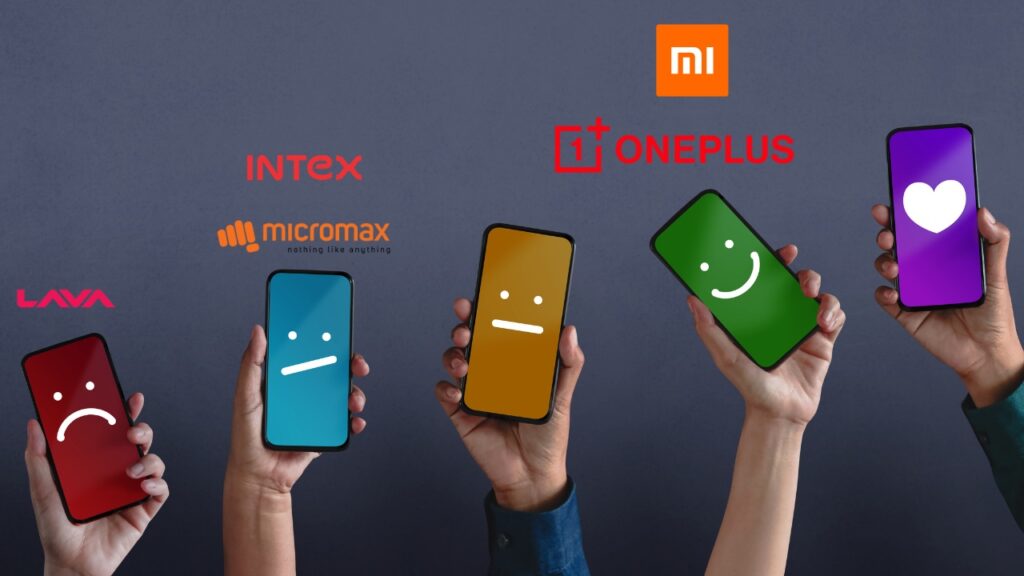A triumphant tune played in the background in the early days of India’s smartphone revolution. The country was on the brink of an unprecedented digital leap, and the stage was set for homegrown brands to take center stage. Micromax, Lava and Intex, with their budget-friendly designs and a message of “Made in India,” seemed destined to be the champions of a new digital age. They embodied the spirit of India’s aspirations: self-reliance, innovation, and pride in homegrown products.

But what followed was nothing short of a business drama. Like the opening scene of an epic, the mighty forces of Chinese smartphone brands—Xiaomi, Oppo, Vivo, and OnePlus—entered the fray. Their arrival in India was not just an expansion but a well-calculated market disruption that fundamentally reshaped the landscape.
The Golden Years of Indian Brands: 2010–2014
Once upon a time, Indian smartphone brands held the crown. Micromax, in particular, saw meteoric success. By 2014, it had surged to the second-largest smartphone brand in India, with a market share of 16.6%. Lava and Intex, riding the wave of India’s growing middle class, captured over 10% of the market. For a brief moment, the dream of an Indian smartphone empire seemed possible.
India’s burgeoning smartphone market, with its 1.3 billion people, has created fertile ground for local players. Micromax launched its Canvas series with an aggressive pricing strategy, offering specs that appealed to the tech-hungry masses. The affordable price points, dual SIM capabilities, and budget-conscious features aligned perfectly with Indian consumers’ growing desire for smartphones.
Yet, this growth was not built to last.
The Chinese Tsunami: A Quiet Revolution (2014–2020)
Enter the Chinese giants: Xiaomi, Oppo, Vivo, and OnePlus. They weren’t just entering India’s market but poised to redefine the smartphone industry. Their growth resulted from a meticulously crafted strategy—cutthroat pricing, aggressive marketing, and a relentless focus on innovation.
Xiaomi: The Game-Changer
In 2014, Xiaomi debuted in India, and the market took notice. With a focus on value for money, Xiaomi quickly capitalized on a critical pain point of Indian consumers: the lack of affordable, high-performance smartphones. By 2017, Xiaomi surpassed Samsung to become India’s #1 smartphone brand, with a 23.5% market share. This success was not a coincidence; it was a culmination of strategic pricing, the flash sale model on e-commerce platforms like Flipkart, and a network of dedicated followers on social media.
Xiaomi’s secret? Localization. They understood India’s diverse consumer base and tailored their marketing to connect with the masses. The introduction of Redmi phones brought 64GB of storage,13MP cameras, and long-lasting batteries to consumers at the price of an entry-level smartphone. The result? 1 million Redmi phones sold in just 18 days during Diwali sales in 2017—a record-breaking feat that made the industry sit up and notice.
Oppo and Vivo: The Offline Conquest
While Xiaomi was shaking things up online, Oppo and Vivo were busy building a retail empire offline. They understood the power of personalized experiences—putting phones in the hands of consumers where they spent their time: in mobile shops and retail stores.
By 2018, Oppo and Vivo had claimed over 20% of India’s smartphone market. Their phones were not just devices—they were status symbols. With endorsements from Bollywood stars, flashy advertisements, and sponsorship of major sporting events like IPL and Pro Kabaddi League, they connected with the Indian consumer on a deeper level. Vivo even officially sponsored the Indian Premier League (IPL) in 2016, securing a place in millions of Indian households.
OnePlus: The Premium Game
Meanwhile, OnePlus, another Chinese brand, focused on a premium segment. By offering flagship-level performance at half the price of Apple or Samsung, OnePlus revolutionized how Indians thought about affordable luxury. Their phones, equipped with cutting-edge Snapdragon processors, 6GB of RAM, and super AMOLED displays, quickly captured the attention of tech enthusiasts.
By 2020, OnePlus dominated India’s premium segment, with 28% of the ₹30,000–₹50,000 price range. They didn’t just sell smartphones; they sold an experience—an elite, aspirational lifestyle that resonated with India’s young, tech-savvy population.
The Demise of Indian Brands: The Numbers Don’t Lie
While the Chinese brands proliferated, India’s local players, once the kings of the smartphone market, began to fade into the background. Micromax, which had been India’s second-largest smartphone brand, saw its market share plummet to a meager 2.5% by 2017. Lava and Intex were also struggling, barely holding on to single-digit market shares. Their inability to innovate at the same pace and a failure to adjust to changing consumer preferences led to their eventual decline.
In contrast, by 2020, Chinese brands controlled over 70% of the Indian smartphone market. Xiaomi led with a 27.4% share, followed by Vivo at 17.5% and Oppo at 12%. The total market share of Indian brands was now less than 5%.
The Turning Point: The Rise of the ‘China’ Effect
What went wrong for Micromax, Lava, and Intex? The answer lies in product strategy, pricing models, and branding. Indian brands have failed to adapt to the fast-evolving needs of India’s smartphone consumers. While Chinese brands like Xiaomi and Oppo reinvested in R&D, adapted to local market needs, and offered aggressive pricing, Indian brands were stuck in the past—overwhelmed by outdated hardware, lagging software, and slow innovation cycles.
Micromax’s Bharat series aimed to tap into the budget-conscious segment—was a missed opportunity, as it lacked the sophistication and appeal of the more tech-savvy offerings from Chinese players. Although Lava and Intex were attempting to launch new models, they couldn’t keep up with the pace at which their competitors were innovating. The market had moved on, and the Indian brands were left behind.
The Takeaway: Why Innovation and Strategy Matter
The rise of Chinese smartphone brands in India underscores one of the most important lessons in business strategy: Adaptability is key. The Chinese companies didn’t just enter the market; they transformed it. Through effective use of market research, aggressive pricing, localized features, and online-to-offline strategies, they were able to win over the hearts and minds of Indian consumers.
For Indian brands to recover and reclaim lost ground, they must focus on innovation, customer loyalty, and value-added services. It’s no longer enough to sell a phone; it’s about creating a brand experience that resonates with a hyper-connected, value-conscious population. The battle for India’s smartphone market is far from over, but one thing is clear: the next wave of winners will be those who understand that business is about more than just products—it’s about understanding the consumer.
Only those who can adapt quickly, innovate constantly, and offer superior customer value will survive as the market matures. The rise and fall of India’s homegrown smartphone giants is a cautionary tale of what happens when local businesses underestimate the power of global competition and fail to keep up with the fast-paced world of tech innovation.
Key Insights & Data
1. Xiaomi became India’s #1 smartphone brand by 2017, overtaking Samsung with a market share of 23.5%.
2. By 2020, Chinese brands controlled 70% of India’s smartphone market, with Xiaomi leading at 27.4%.
3. Micromax’s market share plunged from 16.6% in 2014 to 2.5% by 2017.
4. OnePlus captured 28% of the premium segment (₹30,000–₹50,000 price range) in 2020.
5. Oppo and Vivo combined to hold over 20% of the market by 2018, leveraging offline solid presence and brand sponsorships in Indian cricket and Bollywood.
- write for us - November 9, 2024
- BharatMala – India’s Mega Expressway Transforming Connectivity and Driving Growth - November 8, 2024
- Decoding Flipkart’s Big Billion Days Strategy - November 7, 2024

Lakshay Takkar
Currently pursuing MBA (DEM) from IIM Udaipur.
Previously worked as Senior Product Engineer at Oppo India.


